EXHIBITION: a profile of Beaver Tales & forward movement in Canadian visual history
by Michelle Rothstein

Gordon & Keith, Halifax, Chiffonier, Moose, 1863, walnut, Collection of Elizabeth Scroggie Joy. Photo: Toni Hafkenscheid.
It seems that everywhere you turn these days there are images of nature in our various craft/design (cresign? draft? daft?). Canadians, new and old, can’t seem to escape the wilderness that is just sitting at the border of our urban centres. Since projects like the Souvenir Shop, and stores such as MADE are exploring these themes on a daily basis, one might think hey, finally Canadians are discovering what is unique to them – this must be some sort of trend. Ok sure, that is somewhat true but it ain’t necessarily the first time we are doing so. Beaver Tales: Canadian Art and Design, opening today at the U of T Art Centre traces that history through a multi-disciplinary showcase of both the fine and decorative arts. It’s been happening for a long time people – so it’s time to brush up on your past.
Separated out into 6 distinct themed rooms, the exhibit showcases the inspiration the great outdoors has had on various works ranging from the Group of Seven to Natasha Bailey. The Canada goose, maple leaf, trillium, beaver, antlered animals (basically moose) and evergreens are the symbols upon which the show is based. Martha Kelleher, who curated this show with Rachel Gottlieb, spoke about how simple it was to come up with the symbols as they all resonate within our collective consciousness. While teaching a class at U of T last year, Kelleher asked her diverse set of students what they thought were the symbols of flora and fauna in this country – and their list was similar in many ways to the themes of the exhibit.
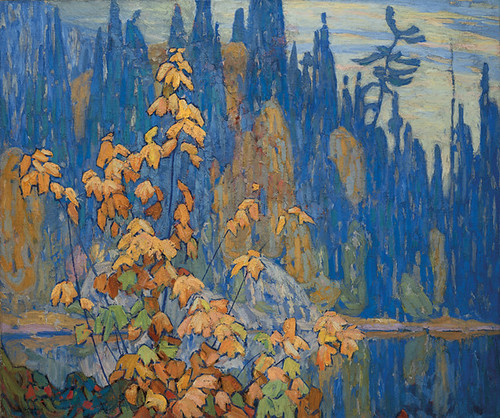
Lawren S. Harris, Autumn, Algoma, oil on canvas, 1920, Art Collection of Victoria University. Photo: National Gallery of Canada, Ottawa.
Beginning with a sculpture of a Canada goose by Emanuel Hahn, the tone of the mixture of works is set. The piece, silver plated cast bronze, of a goose in flight inspired by the Group of Seven, is very modern in style, and yet romantic in theme. It is the perfect opening to an exhibit that covers the 19th century to the present. Hanging directly beside the piece is a silkscreen by Virginia Johnson of the same theme. Over 70 years separate the two, but the imagery is still compelling.
Elizabeth Wilkes Hoey’s two silkscreened pieces are necessities for the TCA readers. They are so contemporary I would have thought they were made yesterday. Her spruce and trillium hangings are both accomplished and beautiful. Honestly, I feel these should be at City of Craft or something! Now, not being skilled in silk-screening nor knowledgeable in this part of our design history, I had never heard of her. Have you? Gottlieb and Kelleher feel this is a sad reality. As Gottlieb notes, “we do not know (these works) - we don’t have the visual vocabulary.” And that is the direct motivation behind this assemblage.

Elizabeth Wilkes Hoey (b. 1915), Wilcam Fabrics, Bronte, Ontario, Trillium, c. 1950s, Hand-screened on linen, Collection of Elizabeth and Martha Wilkes Hoey Moffat.
Even though antlers are everywhere these days, the antler room is lots of fun. Many pieces are fabulous, but one definitely takes the cake. A Chiffonier (mini buffet) from Gordon and Keith could blow your mind. It is so beautiful and traditional as it was made in 1863, but the moose head that sits on the top makes you think it was carved 3 years ago. It was funny, inspired and in my eyes – ironic, even though there wasn’t a trace of irony in the original intention. It was fascinating to experience first-hand a manipulation of these themes of nature. Not necessarily specific to Canada according to Gottlieb, but rather the spawn of post-modernism.
Specific to Canada, that’s really what I was seeking in this show. An incredibly strong and terrific piece that marries the past, present and future is Mary Anne Barkhouse’s Persevere which sits in the Beaver Room. The piece is a bronze beaver asleep on a velvet cushion, but not just any old cushion. She has silk screened an 18th century map from the Canadian Archives outlining the fur trade routes of the day. The beaver is asleep and unaware of the industry that is building all around its kind. I wanted to scream – “wake up! The British are coming!” But the beaver is permanently asleep. Kind of creepy and sad.
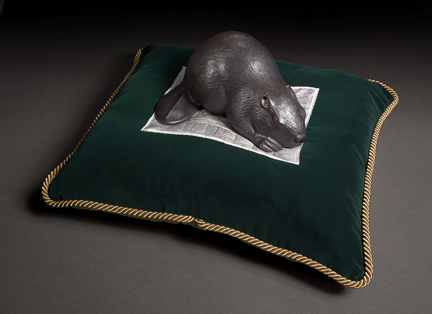
Mary Anne Barkhouse, Persevere, 2006, bronze on velvet cushion with printed silk map, Government of Ontario Art Collection, Archives of Ontario.
The beaver room is in some ways most meaningful in terms of understanding our heritage and culture. Gottlieb explains the beaver was an appropriate symbol for Canada as a country emerging as it connoted even then perseverance and wisdom; it was well-though out. But it is also a worker, a hard and tireless worker. Beaver dams are functional, and besides architectural students and the occasional Discovery Channel program, no one really talks about how beautiful those dams really are (they are quite awesome). And that’s a shame. We as Canadians need to see beyond our beaverdom and recognize that the emerging has emerged and we have a rich visual culture here. This exhibit is merely the tip of the melting iceberg.
But to you crafters, Canada may be the beaver to the world, but WE are the beaver to the design and art world. Understanding part of the heritage of craft is to understand the long pecking order that has kept craft trapped within a narrow set of definitions. Great workers, skilled, but not high form – sound familiar? Both Gottlieb and Kelleher say they don’t subscribe to the antiquated definitions of art, design and craft and we know that less and less people believe in them. But don’t fall asleep on your cushion – now is the time - go and learn a little about where we all come from, embrace the past and demand a voice in the future. Gottlieb and Kelleher want us to all know your names.
Catch the show:
Beaver Tales: Canadian Art and Design
Tuesday September 16 to Saturday December 6 2008
Toronto Art Centre
15 King’s College Circle
www.utac.utoronto.ca
::::::::::::
Michelle Rothstein is a Toronto resident with a passion for design and a love of the hand-made. Her business MOB, is a traveling salon-style show and website (www.mobcollection.com) which brings individual and sophisticated works to the design hungry for the sheer love it. She is psyched that Toronto is getting much more styley in its old age.

Gordon & Keith, Halifax, Chiffonier, Moose, 1863, walnut, Collection of Elizabeth Scroggie Joy. Photo: Toni Hafkenscheid.
Separated out into 6 distinct themed rooms, the exhibit showcases the inspiration the great outdoors has had on various works ranging from the Group of Seven to Natasha Bailey. The Canada goose, maple leaf, trillium, beaver, antlered animals (basically moose) and evergreens are the symbols upon which the show is based. Martha Kelleher, who curated this show with Rachel Gottlieb, spoke about how simple it was to come up with the symbols as they all resonate within our collective consciousness. While teaching a class at U of T last year, Kelleher asked her diverse set of students what they thought were the symbols of flora and fauna in this country – and their list was similar in many ways to the themes of the exhibit.

Lawren S. Harris, Autumn, Algoma, oil on canvas, 1920, Art Collection of Victoria University. Photo: National Gallery of Canada, Ottawa.
Elizabeth Wilkes Hoey’s two silkscreened pieces are necessities for the TCA readers. They are so contemporary I would have thought they were made yesterday. Her spruce and trillium hangings are both accomplished and beautiful. Honestly, I feel these should be at City of Craft or something! Now, not being skilled in silk-screening nor knowledgeable in this part of our design history, I had never heard of her. Have you? Gottlieb and Kelleher feel this is a sad reality. As Gottlieb notes, “we do not know (these works) - we don’t have the visual vocabulary.” And that is the direct motivation behind this assemblage.

Elizabeth Wilkes Hoey (b. 1915), Wilcam Fabrics, Bronte, Ontario, Trillium, c. 1950s, Hand-screened on linen, Collection of Elizabeth and Martha Wilkes Hoey Moffat.
Specific to Canada, that’s really what I was seeking in this show. An incredibly strong and terrific piece that marries the past, present and future is Mary Anne Barkhouse’s Persevere which sits in the Beaver Room. The piece is a bronze beaver asleep on a velvet cushion, but not just any old cushion. She has silk screened an 18th century map from the Canadian Archives outlining the fur trade routes of the day. The beaver is asleep and unaware of the industry that is building all around its kind. I wanted to scream – “wake up! The British are coming!” But the beaver is permanently asleep. Kind of creepy and sad.

Mary Anne Barkhouse, Persevere, 2006, bronze on velvet cushion with printed silk map, Government of Ontario Art Collection, Archives of Ontario.
But to you crafters, Canada may be the beaver to the world, but WE are the beaver to the design and art world. Understanding part of the heritage of craft is to understand the long pecking order that has kept craft trapped within a narrow set of definitions. Great workers, skilled, but not high form – sound familiar? Both Gottlieb and Kelleher say they don’t subscribe to the antiquated definitions of art, design and craft and we know that less and less people believe in them. But don’t fall asleep on your cushion – now is the time - go and learn a little about where we all come from, embrace the past and demand a voice in the future. Gottlieb and Kelleher want us to all know your names.
Catch the show:
Beaver Tales: Canadian Art and Design
Tuesday September 16 to Saturday December 6 2008
Toronto Art Centre
15 King’s College Circle
www.utac.utoronto.ca
::::::::::::
Michelle Rothstein is a Toronto resident with a passion for design and a love of the hand-made. Her business MOB, is a traveling salon-style show and website (www.mobcollection.com) which brings individual and sophisticated works to the design hungry for the sheer love it. She is psyched that Toronto is getting much more styley in its old age.
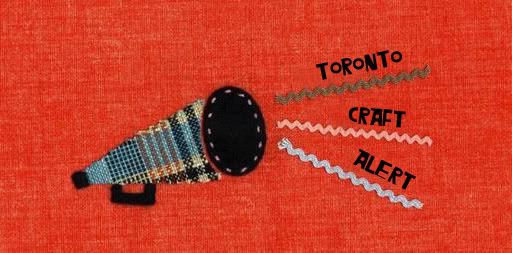






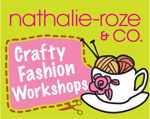




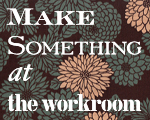




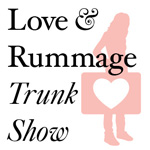




0 Comments:
Post a Comment
<< Home